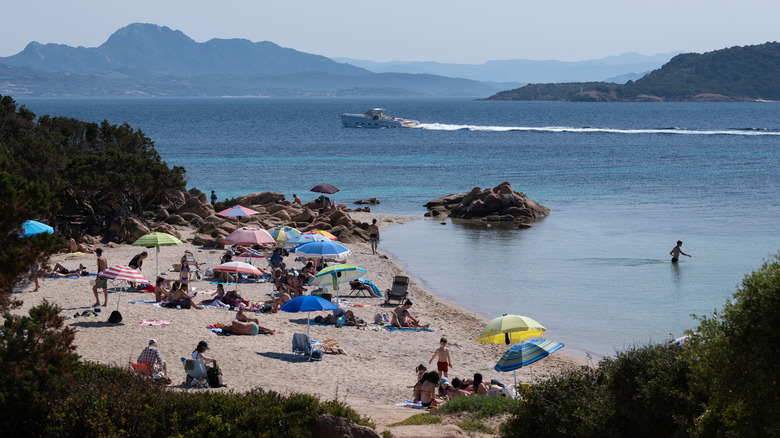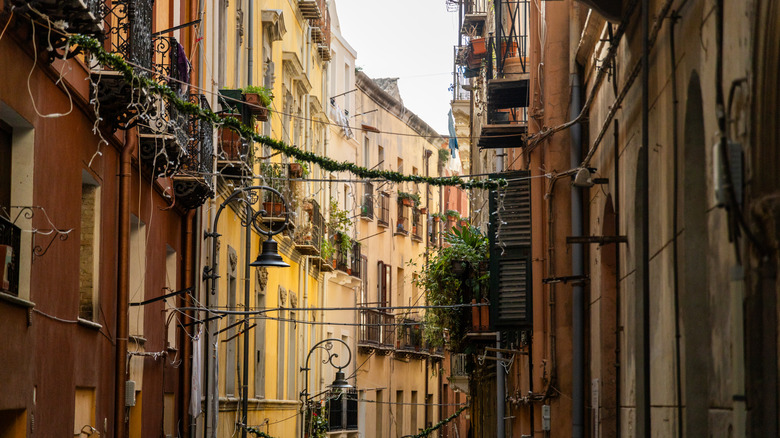Taking This Beautiful But Forbidden Keepsake From Sardinia's Beaches Could Cost Tourists Big
The sands of Sardinia are so pearly white, you almost want to take some home. That's one reason tourists come to this Mediterranean island, to bask in the sun-bleached beaches and transparent opal waters. Walking over its powdery grains feels like the earth is hugging your feet. You could just imagine filling a mason jar with these sands, or a wine bottle, or a terrarium. Beaches come in every color, and many are beautiful to behold; but there's something pure and magical about these gleaming dunes. Surely you could walk away with a water bottle full of sand and nobody would notice. Sardinia has nearly 1,150 miles of coast! Who would get into a tizzy about one tiny sample?
Well, think again: The government of Sardinia cares very much about its sand, as well as its shells, fossils, and other natural debris. If you're caught trying to smuggle these items out, you could be fined up to $3,248. They're not kidding around: Tourists have been arrested for trying to pilfer pebbles and stalagmites from Sardinia's shores, and many have been threatened with jail time. Italy may feel like a freewheeling country in certain ways, but there are many things tourists should never do when visiting, and eroding the beaches of Sardinia in order to have a fun keepsake is utterly disrespectful — and a bona fide crime with painful consequences.
These kinds of laws have become popular around the world, as ocean-bordering nations attempt to protect their coastal environments. "Beach thefts" have a cumulative effect, especially in well-trafficked destinations, which can damage ecosystems and ruin a place's natural beauty. And given Sardinia's history, it's no wonder they're prickly about it.
Why Sardinia protects its beach sand
If you're struggling to imagine Sardinia on a map, here's some background: This rocky island stands in the western Mediterranean, north of Sicily and south of Corsica. It is technically part of Italy, although the people have a distinct culture and many residents speak a separate language, Sardo. Invaders overran Sardinia several times, including the Ancient Romans (who treated locals harshly) and Moorish pirates, or corsairs, during the Middle Ages. This has always been tragic for the Sardinian people, who have a long tradition of raising sheep in the island's grassy interior and have never antagonized mainlanders. As a result, Sardinians have a reputation for being suspicious of outsiders and slow to warm up to anyone they don't already know.
Sociology aside, Sardinia received more than 7 million tourists in 2023, which is over four times the island's total population, and unlike those inland shepherds, a great number of them want to hit the beach. Sardinia's beaches aren't all soft and lily-white; many have pebbled surfaces or grains like rice or raw sugar. The seashore is famous for coasts, caves, hiking, and camping, which are all reasons this Mediterranean island is a must-visit for thrilling outdoor adventures. Travelers love these beaches, and the mesmerizing glow of the white sand has seduced more than one to bottle up a fistful and take it home.
In short, Sardinia has thousands of years of grievances, plus waves of thoughtless tourists and finite resources to preserve. Sardinia is also a major stopover for migrating birds and an important habitat for flamingos, dolphins, octopuses, and falcons. The last thing locals need is for a bunch of backpackers to dig up their iconic beaches because they think a little sand will look pretty on a mantle.
Sardinia, a gem in the Mediterranean
Sardinia is a wonderful place to visit, with its unique culture, little-known history, and rugged scenery. Unlike obscurer Mediterranean islands, like Cyprus or Crete, Sardinia shares language and architectural style with the rest of Italy, so much of this region will feel familiar and accessible. If you're flying into the island, you'll most likely touch down at Cagliari Airport, located just outside Sardinia's capital and largest city. Cagliari is a dense city with tile roofs and old narrow streets, the classic portrait of Mediterranean living. From the moment you check into your hotel, you can plan a walk to Poetto Beach, one of those white-sand beauties that extends a full 5 miles. This is a good thing, as massive crowds have given this place the nickname "Spiaggia dei Centomila," or "Beach of a Hundred Thousand."
The periphery of Sardinia is stippled with hotels, and if you've endured the suffocating prices of Western Europe, you'll be astonished at the $100 to $150-per-night deals you can snatch at island accommodations. While you're exploring these epic coasts, consider a stop at the breathtaking beaches of the Golfo di Orosei, where sands and cliffs dominate a 20-mile coast. There is so much to love about this overlooked land mass, and beachgoers could explore its fringes for months. Just remember to leave the scenery where it is.


